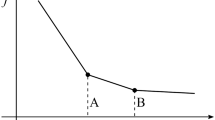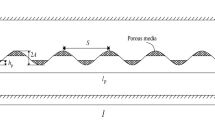Abstract
The asymmetric plate heat exchanger (APHE) has the possibility of achieving balanced pressure drops on both hot and cold sides for situations with unbalanced flow, which may in turn enhance the heat transfer. In this paper, the single-phase water flow and heat transfer of an APHE consisted of two types of plates are numerically (400⩽Re⩽ 12000) and experimentally (400⩽Re⩽ 3400) investigated. The numerical model is verified by the experimental results. Simulations are conducted to study the effects of N, an asymmetric index proposed to describe the geometry of APHEs. The correlations of the Nusselt number and friction factor in the APHEs are determined by taking N and working fluids into account. It is found that an optimal Nexists where the pressure drops are balanced and the heat transfer area reaches the minimum. The comparison between heat transfer and flow characteristics of the APHEs and the conventional plate heat exchanger (CPHE) is made under various flow rate ratios of the hot side and the cold side and different allowable pressure drops. The situations under which APHE may perform better are identified based on a comprehensive index Nu/f1/3.
Similar content being viewed by others
References
Odejobi O J, Adejokun A E, Al-Mutairi E M. Heat exchanger network synthesis incorporating enhanced heat transfer techniques. Applied Thermal Engineering, 2015, 89: 684–692
Caputo A C, Pelagagge P M, Salini P. Heat exchanger optimized design compared with installed industrial solutions. Applied Thermal Engineering, 2015, 87: 371–380
Doo J H, Ha M Y, Min J K, Stieger R, Rolt A, Son C. An investigation of cross-corrugated heat exchanger primary surfaces for advanced intercooled-cycle aero engines (Part-I: Novel geometry of primary surface). International Journal of Heat and Mass Transfer, 2012, 55(19–20): 5256–5267
Bejan A, Alalaimi M, Sabau A S, Lorente S. Entrance-length dendritic plate heat exchangers. International Journal of Heat and Mass Transfer, 2017, 114: 1350–1356
Abu-Khader M M. Plate heat exchangers: recent advances. Renewable & Sustainable Energy Reviews, 2012, 16(4): 1883–1891
Abou Elmaaty T M, Kabeel A E, Mahgoub M. Corrugated plate heat exchanger review. Renewable & Sustainable Energy Reviews, 2017, 70: 852–860
Nilpueng K, Keawkamrop T, Ahn H S, Wongwises S. Effect of chevron angle and surface roughness on thermal performance of single-phase water flow inside a plate heat exchanger. International Communications in Heat and Mass Transfer, 2018, 91: 201–209
Kanaris A G, Mouza A A, Paras S V. Optimal design of a plate heat exchanger with undulated surfaces. International Journal of Thermal Sciences, 2009, 48(6): 1184–1195
Zhang L, Che D. Influence of corrugation profile on the thermalhydraulic performance of cross-corrugated plates. Numerical Heat Transfer, 2011, 59(4): 267–296
Doo J H, Ha M Y, Min J K, Stiegerc R, Roltc A, Sona C. An investigation of cross-corrugated heat exchanger primary surfaces for advanced intercooled-cycle aero engines (Part-II: Design optimization of primary surface). International Journal of Heat Mass Transfer, 2013, 61(s19–20): 138–148
Utriainen E, Sunden B. Evaluation of the cross corrugated and some other candidate heat transfer surfaces for microturbine recuperators. Journal of Engineering for Gas Turbines and Power, 2002, 124(3): 550–560
Focke W W. Asymmetrically corrugated plate heat-exchanger plates. International Communications in Heat and Mass Transfer, 1985, 12(1): 67–77
Kim M, Ha M Y, Min J K, Stieger R, Rolt A, Son C. Numerical study on the cross-corrugated primary surface heat exchanger having asymmetric cross-sectional profiles for advanced inter-cooled-cycle aero engines. International Journal of Heat and Mass Transfer, 2013, 66: 139–153
Vestergren U. Plate heat exchanger. United State Patent 6237679B1, 2001
Dahlberg T. Asymmetric heat exchanger. European Patent 2267391A2, 2010
Funke M. Asymmetric plate heat exchanger. European Patent 2674718, 2013
Lee H, Hwang Y, Radermacher R, Chun H H. Experimental investigation of novel heat exchanger for low temperature lift heat pump. Energy, 2013, 51: 468–474
Jain S, Joshi A, Bansal P K. A new approach to numerical simulation of small sized plate heat exchangers with chevron plates. Journal of Heat Transfer, 2007, 129(3): 291–297
Sharif A, Ameel B, T’Jollyn I, Lecompte S, De Paepe M. Comparative performance assessment of plate heat exchangers with triangular corrugation. Applied Thermal Engineering, 2018, 141: 186–199
Zhang Y, Jiang C, Yang Z, Zhang Y, Bai B. Numerical study on heat transfer enhancement in capsule-type plate heat exchangers. Applied Thermal Engineering, 2016, 108: 1237–1242
Han X H, Cui L Q, Chen S J, Chen G M, Wang Q. A numerical and experimental study of chevron, corrugated-plate heat exchangers. International Communications in Heat and Mass Transfer, 2010, 37 (8): 1008–1014
Gullapalli V S, Sunden B. CFD simulation of heat transfer and pressure drop in compact brazed plate heat exchangers. Heat Transfer Engineering, 2014, 35(4): 358–366
Tiwari A K, Ghosh P, Sarkar J, Dahiya H, Parekh J. Numerical investigation of heat transfer and fluid flow in plate heat exchanger using nanofluids. International Journal of Thermal Sciences, 2014, 85: 93–103
Wu Q G. The optimality of orthogonal experimental designs. Acta Mathematicae Applicatae Sinica, 1978, 4: 283–299
Wheeler A J, Ganji A R. Introduction to Engineering Experimentation. New Jersey: Pearson Prentice Hall, 2004
Lee J, Lee K S. Friction and colburn factor correlations and shape optimization of chevron-type plate heat exchangers. Applied Thermal Engineering, 2015, 89: 62–69
Sarraf K, Launay S, Tadrist L. Complex 3D-flow analysis and corrugation angle effect in plate heat exchangers. International Journal of Thermal Sciences, 2015, 94: 126–138
Martin H. A theoretical approach to predict the performance of chevron-type plate heat exchangers. Chemical Engineering and Processing, 1996, 35(4): 301–310
Fernández-Seara J, Uhía F J, Sieres J, Campo A. A general review of the Wilson plot method and its modifications to determine convection coefficients in heat exchange devices. Applied Thermal Engineering, 2007, 27(17–18): 2745–2757
Acknowledgements
This work was supported by the National Key Research and Development Program of China (No. 2016YFB0901404).
Author information
Authors and Affiliations
Corresponding author
Rights and permissions
About this article
Cite this article
Zhang, S., Niu, X., Li, Y. et al. Numerical simulation and experimental research on heat transfer and flow resistance characteristics of asymmetric plate heat exchangers. Front. Energy 14, 267–282 (2020). https://doi.org/10.1007/s11708-020-0662-7
Received:
Accepted:
Published:
Issue Date:
DOI: https://doi.org/10.1007/s11708-020-0662-7




